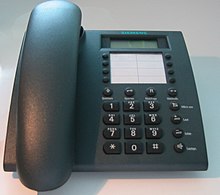Inquiry button

In telephony, the inquiry key , often also called the R key , is used to signal commands to private or public telecommunications networks that go beyond the transmission of the call number to be called. This can e.g. B. be a transfer of a call to another participant.
Different signaling modes have to be distinguished depending on the type of telephone connection .
Function on the ISDN connection
The R key of a telephone on an ISDN connection or on an S 0 bus triggers the sending of a digital control message. The "HOLD" message is sent to the switching facility ( switching center or telephone system ) in the D channel . HOLD causes the other call participant in the waiting state is brought.
Function with IP telephony
On a telephone with IP telephony , the R key triggers the sending of a digital control message. A message is sent via the signaling protocol , which puts the other party on hold. With the frequently used signaling protocol SIP , the command "Call Hold" is sent for this purpose.
Function with analog telephone interfaces
Flash button
The R key causes the line connection to be interrupted for 70–90 ms.
This function is often used with analogue terminal interfaces of telephone systems that support two-wire cabling and DTMF commands. So that the telephone system can recognize that the transmitted DTMF tones are commands to the telephone system and not DTMF commands e.g. B. to control a three-way conference in the public exchange or to control an answering machine at the other end, the line connection is interrupted for 70-90 ms and the telephone system switches to command mode. This function is known as the flash function .
Hook flash
The R key causes the line connection to be interrupted for 170-310 ms.
With this function, analog telecommunications terminals signal to the exchange that the following DTMF tones are commands to the exchange (e.g. to control service features such as three-way conference and Brokering ). This function is known as the hook flash function , as it can also be achieved by briefly hanging up the receiver or briefly pressing the hook switch ( hook = hook). In the case of very old telephones with a button, a so-called flicker button could be implemented by breaking the bridge 2'-W2 . The connection was interrupted while the button was pressed.
Earth button
The R button establishes an electrical connection with a third line, the earth wire .
This signaling is obsolete today and worked in the formerly common branch networks with an additional earth connection on the telephone socket. The earth button on the telephone set switched the earth potential to the a-wire of the connection line. The protective conductor of a mains socket was not allowed to be used for this. If necessary, external auxiliary earth electrodes, e.g. B. water or heating pipes can be used. The earth key function was common in telephone systems that use pulse dialing . It is unusual for systems that use multi-frequency dialing . Today's telephones usually no longer have an earth button.
See also
literature
- Handheld dictionary of electrical telecommunications ; 2nd Edition; Band Q-Z; P. 1425–1426 (inquiry / inquiry machines)
Remarks
- ↑ a b The exact area in which a telephone system already recognizes the line interruption or still recognizes it as a flash depends on the particular system.
- ↑ The specified duration of the connection interruption applies to German exchanges, other values apply to Austria and Switzerland .


